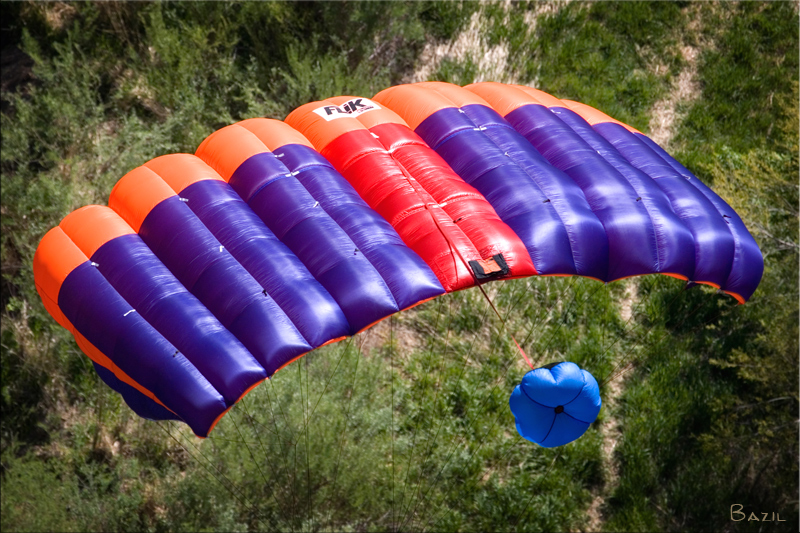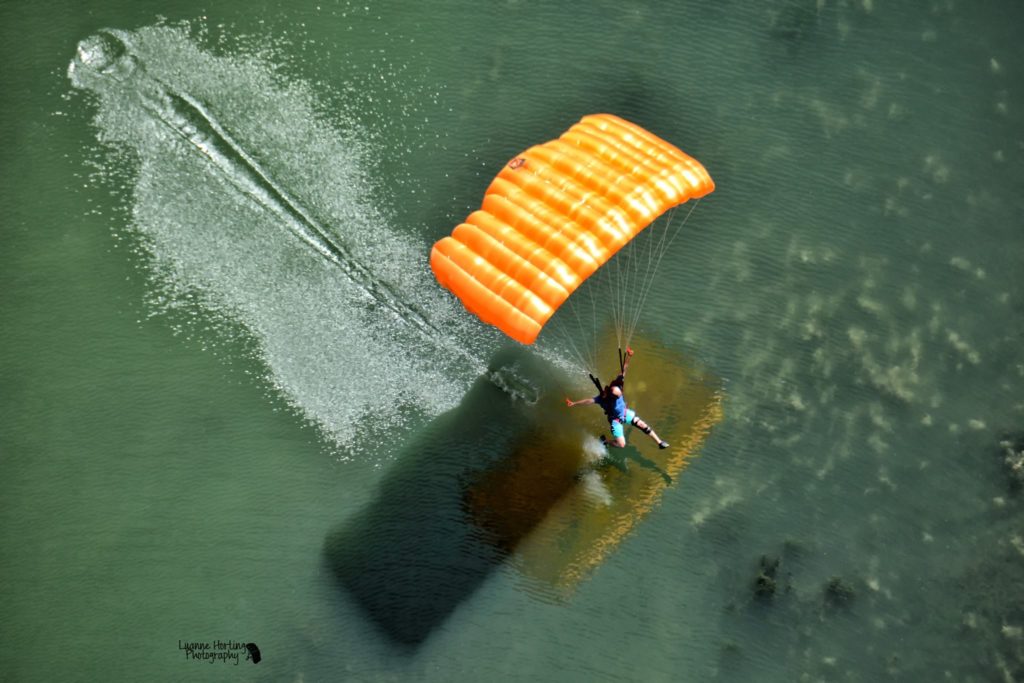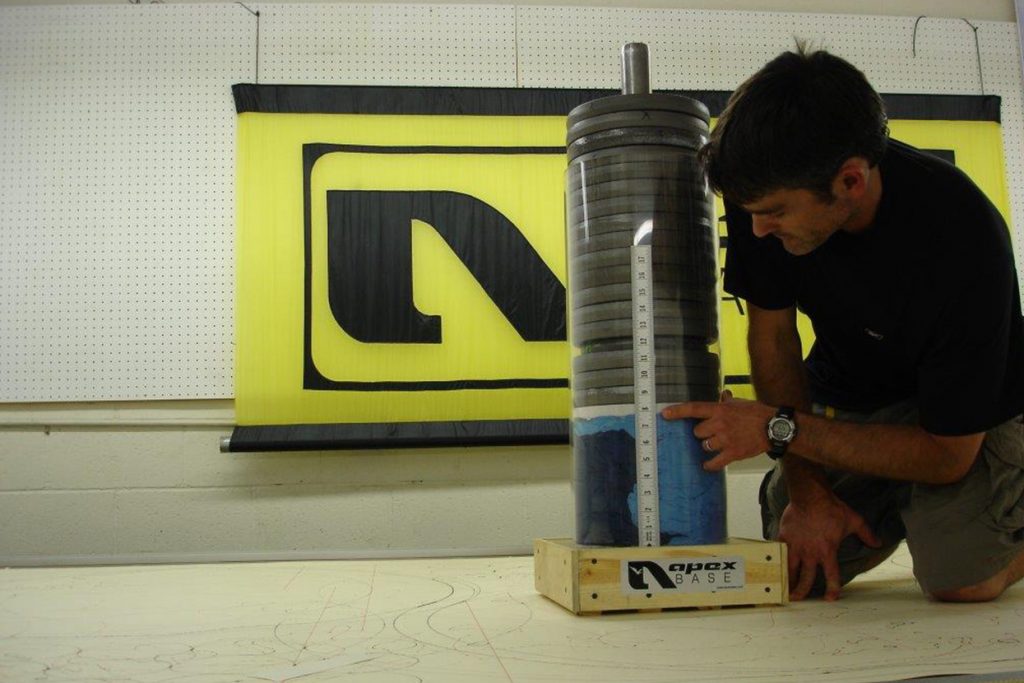A common question we get at Apex BASE is, “Why don’t any of your canopies have a ZP (zero-porosity) nose?”
Over the years our team has played with a lot of different canopy variations, including many iterations with this design feature (there are still a lot of FLiK canopies flying today with ZP noses, and even a few with full ZP top skins). The purpose of this article is to discuss our experience with those designs and why we feel our current canopy lineup is better without this design element.
In no way is this article meant to critique the use of this design element by other manufacturers, on other canopy models. This is only intended to discuss why we’re not currently offering ZP noses on our canopy lineup. Apex BASE has used them in the past, and we may use them again in the future. For now we’ve decided not to. Here’s why:

An Apex BASE FLiK, with ZP used on the top skin of the leading edge.
Canopy Lifespan:
When we apply a ZP nose to our designs the biggest benefit we’re seeing is improved canopy performance as the canopy ages. We see very little, if any, performance enhancement on our canopies early in their life. That said, it is true that ZP at the leading edge of the canopy will help maintain performance on aging canopies better than more porous fabric (like F-111 or UltraLite). This left us with the question: Is a potentially longer lifespan worth any drawbacks of the design, and is the longevity of our BASE canopies a problem that needs solving in the first place?
On both counts, we believe the answer is “no.” We’ve seen many years and many thousands of jumps put on Apex BASE canopies built entirely from 0-3 cfm (F-111) style fabric and UltraLite fabric with excellent results in durability and longevity. In one (admittedly extreme) case we had a customer jumping an UltraLite canopy with nearly 1000 jumps still flying, flaring, and landing well enough that the jumper felt no need to retire the canopy. While we do not expect every canopy to last this long, it is one of many anecdotal cases we’ve seen demonstrating the longevity of our products.

Our team has been very happy with the performance characteristics of canopies built entirely from standard and UltraLite fabrics even as they age.
Canopy Replacement:
It’s not too often that we see a canopy flown all the way to the end of its service life. The most important reason being that this is BASE jumping and you only have one parachute on your back. Do you really want to push your canopy close to the very end of its useful life? We think that most jumpers are choosing to be prudent and retire their canopies well before they need to be grounded, and before the ZP nose can be credited with extending the canopy’s life in a meaningful way.
Here’s a very common scenario that we come across:
A jumper sends in their older canopy, with around 500 jumps on it. It needs a new lineset, a couple of patches, and a new tail pocket. In most cases we see jumpers choosing to retire this older, often damaged, canopy and purchase a new one. This is usually the more fiscally (and physically) sound decision when compared to dumping hundreds of dollars into an aging canopy to try and squeeze a few more trips out of it.
On a single parachute system we always advocate against pushing your canopy anywhere near the end of its airworthiness.
Opening Performance:
All else being equal, we’ve found that canopies with ZP noses open harder. In numerous apples-to-apples comparisons by a range of jumpers we’ve observed canopies with ZP noses, with everything else being identical, consistently opening harder on both slider-up and slider-off deployments. On our canopies we found these openings to be a meaningful drawback, and we prefer the opening characteristics of full F-111 and UltraLite Apex BASE canopies.
Packing:
Anyone who has packed a brand new skydiving canopy knows that packing ZP…well…sucks. It’s slippery, and squirmy, and can be difficult to manage especially for newer packers. There is clearly a big difference between packing a fully ZP canopy and a BASE canopy with a partial ZP topskin, but it is objectively true that introducing any amount of ZP to the canopy will make it more slippery, squirmy, and difficult to manage in that section. It was not uncommon for us to see students really struggling with it during our FJCs, to the point where we became concerned about the heading performance that could result from those…suboptimal…pack jobs.
Pack Volume & Weight:
ZP contributes to a larger pack volume and a heavier parachute, primarily by requiring the use of additional seams when connecting the ZP panels to the rest of the canopy. This means that introducing a ZP panel results in a parachute that is heavier and with a larger pack volume, every time.
Apex BASE conducts volume tests on nearly all designs from all major manufacturers and compiles this data. This helps us appropriately size containers for all canopy sizes and styles, and also provides insight into how certain design elements impact weight and volume.

Apex BASE conducts volume tests on nearly all designs from all major manufacturers and compiles this data.
Conclusion:
Ultimately we’ve decided that the the primary benefit of using a ZP nose, a potentially longer service life, isn’t worth the aforementioned negatives that we’ve observed on our canopy lineup and we decided to move away from using ZP on our designs at this time. Not every manufacturer came to the same conclusion on their parachutes. There are a lot of very capable canopies out there that utilize a ZP nose and in no way is this a commentary on the use of ZP on those canopies.
In summary: When analyzing Apex BASE canopies with and without ZP noses in an apples-to-apples comparison, we found the canopies without ZP produced the best overall package.
All of our current canopies are built from full F-111/UltraLite. This means less seams, less weight, less volume. Based on the data we’ve gathered here in our shop Apex BASE is able to offer the lightest and lowest volume all-around BASE canopies on the market.
When you are evaluating your canopy options please remember that there is no perfect BASE canopy design. There are only different canopy designs with different trade-offs being made to achieve the best possible balance of performance. That optimal balance is not a matter of fact. It’s a matter of opinion that will be different for each individual jumper based on his/her experience, jumping style, location, etc. It is important for every jumper to evaluate their needs, strengths, and weaknesses in order to select a canopy that best compliments their jumping style.
If you have any questions about which canopy is right for you, never hesitate to reach out to us. We’re here and happy to chat BASE!
